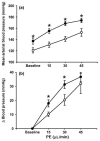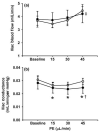Alpha-adrenoceptor-mediated vasoconstriction is not involved in impaired functional vasodilation in the obese Zucker rat
- PMID: 18177478
- PMCID: PMC2788304
- DOI: 10.1111/j.1440-1681.2007.04849.x
Alpha-adrenoceptor-mediated vasoconstriction is not involved in impaired functional vasodilation in the obese Zucker rat
Abstract
1. Obesity/metabolic syndrome is associated with augmented a-adrenoceptor sensitivity and impaired hyperaemic responses to exercise. Thus, it is possible that this elevated a-adrenoceptor constriction contributes to the blunted hyperaemic response. 2. Male lean and obese Zucker rats were instrumented for acute measurements of blood pressure (BP) and iliac blood flow (BF). Changes in BP and BF were determined in anaesthetized animals in response to intravenous administration of increasing doses of the a(1)-adrenoceptor agonist phenylephrine (PE). Once BF and BP returned to normal, a single bolus of the a-adrenoceptor antagonist phentolamine (0.5 mg) was administered. In separate animals, the spinotrapezius muscle was exteriorized for direct in situ observation of the microcirculation in response to phentolamine and muscle contraction. 3. Administration of PE demonstrated that iliac BF is highly autoregulated in the face of increasing perfusion pressure. Iliac conductance following phentolamine was significantly greater in obese rats. Following phentolamine administration, iliac vascular conductance was significantly greater in obese rats compared with lean animals. However, a-adrenoceptor blockade did not significantly alter arteriolar diameter in the spinotrapezius muscle during muscle contraction in either lean or obese animals. 4. These results suggest a greater contribution of the a-adrenoceptors in basal hindlimb vascular tone in obese rats. Furthermore, an augmented a-adrenoceptor-mediated vasoconstriction may not contribute to the impaired functional dilation in anaesthetized obese rats.
Figures






 ) in the spinotrapezius muscle of lean and obese rats. (□), baseline. Arterioles were pretreated with SQ29548 (10 μmol/L) for 30 min. Data are presented as the mean±SEM (n = 4 per group). *P < 0.05 compared with lean control; †P < 0.05 compared with baseline. Bars indicate maximal diameter (10 μmol/L adenosine induced).
) in the spinotrapezius muscle of lean and obese rats. (□), baseline. Arterioles were pretreated with SQ29548 (10 μmol/L) for 30 min. Data are presented as the mean±SEM (n = 4 per group). *P < 0.05 compared with lean control; †P < 0.05 compared with baseline. Bars indicate maximal diameter (10 μmol/L adenosine induced).Similar articles
-
Enhanced arteriolar alpha-adrenergic constriction impairs dilator responses and skeletal muscle perfusion in obese Zucker rats.J Appl Physiol (1985). 2004 Aug;97(2):764-72. doi: 10.1152/japplphysiol.01216.2003. Epub 2004 Apr 9. J Appl Physiol (1985). 2004. PMID: 15075303
-
Divergence between arterial perfusion and fatigue resistance in skeletal muscle in the metabolic syndrome.Exp Physiol. 2011 Mar;96(3):369-83. doi: 10.1113/expphysiol.2010.055418. Epub 2010 Dec 1. Exp Physiol. 2011. PMID: 21123363 Free PMC article.
-
Insulin resistance and impaired functional vasodilation in obese Zucker rats.Am J Physiol Heart Circ Physiol. 2008 Apr;294(4):H1658-66. doi: 10.1152/ajpheart.01206.2007. Epub 2008 Feb 22. Am J Physiol Heart Circ Physiol. 2008. PMID: 18296567
-
Improved functional vasodilation in obese Zucker rats following exercise training.Am J Physiol Heart Circ Physiol. 2011 Sep;301(3):H1090-6. doi: 10.1152/ajpheart.00233.2011. Epub 2011 Jun 17. Am J Physiol Heart Circ Physiol. 2011. PMID: 21685273 Free PMC article.
-
Integration of skeletal muscle resistance arteriolar reactivity for perfusion responses in the metabolic syndrome.Am J Physiol Regul Integr Comp Physiol. 2009 Jun;296(6):R1771-82. doi: 10.1152/ajpregu.00096.2009. Epub 2009 Apr 22. Am J Physiol Regul Integr Comp Physiol. 2009. PMID: 19386988 Free PMC article.
Cited by
-
Increased haemodynamic adrenergic load with isoflurane anaesthesia in type 2 diabetic and obese rats in vivo.Cardiovasc Diabetol. 2014 Dec 10;13:161. doi: 10.1186/s12933-014-0161-4. Cardiovasc Diabetol. 2014. PMID: 25496763 Free PMC article.
-
Adipocyte-derived factor reduces vasodilatory capability in ob-/ob- mice.Am J Physiol Heart Circ Physiol. 2009 Aug;297(2):H689-95. doi: 10.1152/ajpheart.01327.2008. Epub 2009 Jun 5. Am J Physiol Heart Circ Physiol. 2009. PMID: 19502550 Free PMC article.
-
Air pollution particulate matter collected from an Appalachian mountaintop mining site induces microvascular dysfunction.Microcirculation. 2013 Feb;20(2):158-69. doi: 10.1111/micc.12014. Microcirculation. 2013. PMID: 22963349 Free PMC article.
-
Altered neurovascular control of the resting circulation in human metabolic syndrome.J Physiol. 2012 Dec 1;590(23):6109-19. doi: 10.1113/jphysiol.2012.239780. Epub 2012 Oct 1. J Physiol. 2012. PMID: 23027821 Free PMC article. Clinical Trial.
-
Peripheral Blood Flow Regulation in Human Obesity and Metabolic Syndrome.Exerc Sport Sci Rev. 2016 Jul;44(3):116-22. doi: 10.1249/JES.0000000000000083. Exerc Sport Sci Rev. 2016. PMID: 27223271 Free PMC article. Review.
References
-
- Ford ES. Prevalence of the metabolic syndrome in US populations. Endocrinol. Metab. Clin. North Am. 2004;33:333–50. - PubMed
-
- Ford ES, Giles WH, Dietz WH. Prevalence of the metabolic syndrome among US adults: Findings from the Third National Health and Nutrition Examination Survey. JAMA. 2002;287:356–9. - PubMed
-
- Frisbee JC. Impaired hemorrhage tolerance in the obese Zucker rat model of metabolic syndrome. J. Appl. Physiol. 2006;100:465–73. - PubMed
-
- Naik JS, Xiang L, Hester RL. Enhanced role for RhoA-associated kinase in adrenergic-mediated vasoconstriction in gracilis arteries from obese Zucker rats. Am. J. Physiol. Regul. Integr. Comp. Physiol. 2006;290:R154–61. - PubMed
-
- Stepp DW, Frisbee JC. Augmented adrenergic vasoconstriction in hypertensive diabetic obese Zucker rats. Am. J. Physiol. Heart Circ. Physiol. 2002;282:H816–20. - PubMed
Publication types
MeSH terms
Substances
Grants and funding
LinkOut - more resources
Full Text Sources
Medical
Miscellaneous

